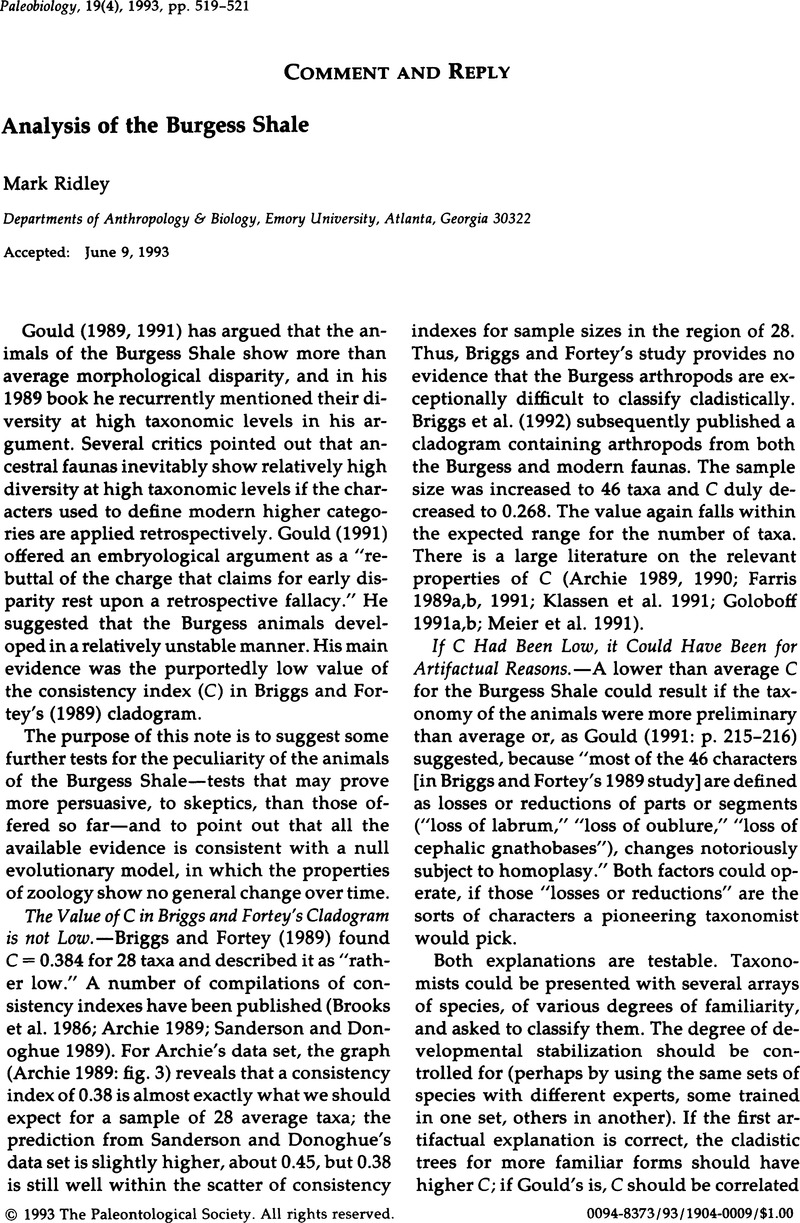Crossref Citations
This article has been cited by the following publications. This list is generated based on data provided by Crossref.
Foote, Mike
1995.
Morphological diversification of Paleozoic crinoids.
Paleobiology,
Vol. 21,
Issue. 3,
p.
273.
Wagner, Peter J.
1995.
Testing evolutionary constraint hypotheses with early Paleozoic gastropods.
Paleobiology,
Vol. 21,
Issue. 3,
p.
248.
Sterelny, Kim
1995.
Understanding Life: Recent Work in Philosophy of Biology.
The British Journal for the Philosophy of Science,
Vol. 46,
Issue. 2,
p.
155.
McShea, Daniel W.
1996.
PERSPECTIVE METAZOAN COMPLEXITY AND EVOLUTION: IS THERE A TREND?.
Evolution,
Vol. 50,
Issue. 2,
p.
477.
Fortey, R.A.
Briggs, D.E.G.
and
WILLS, M.A.
1996.
The Cambrian evolutionary ‘explosion’: decoupling cladogenesis from morphological disparity.
Biological Journal of the Linnean Society,
Vol. 57,
Issue. 1,
p.
13.
Foote, Mike
1997.
The Evolution of Morphological Diversity.
Annual Review of Ecology and Systematics,
Vol. 28,
Issue. 1,
p.
129.
McShea, Daniel W.
1998.
POSSIBLE LARGEST-SCALE TRENDS IN ORGANISMAL EVOLUTION: Eight “Live Hypotheses”.
Annual Review of Ecology and Systematics,
Vol. 29,
Issue. 1,
p.
293.
Ahouse, Jeremy C.
1998.
The Tragedy of a priori Selectionism: Dennett and Gould on Adaptationism.
Biology & Philosophy,
Vol. 13,
Issue. 3,
p.
359.
Sterelny, Kim
1999.
Supply-side biology.
Metascience,
Vol. 8,
Issue. 3,
p.
405.
MIDDLETON, KEVIN M.
and
GATESY, STEPHEN M.
2000.
Theropod forelimb design and evolution.
Zoological Journal of the Linnean Society,
Vol. 128,
Issue. 2,
p.
149.
Sterelny, Kim
2000.
Development, Evolution, and Adaptation.
Philosophy of Science,
Vol. 67,
Issue. S3,
p.
S369.
Wills, Matthew A.
2001.
How good is the fossil record of arthropods? An assessment using the stratigraphic congruence of cladograms.
Geological Journal,
Vol. 36,
Issue. 3-4,
p.
187.
Croft, William
2002.
The Darwinization of Linguistics.
Selection,
Vol. 3,
Issue. 1,
p.
75.
Li, Meijun
Wang, Tieguan
Wang, Chunjiang
and
Zhang, Weibiao
2006.
Molecular composition and indigenity of organic matter in Late Neoproterozoic sedimentary rocks from the Yangtze region, South China.
Chinese Journal of Geochemistry,
Vol. 25,
Issue. 4,
p.
318.
PETERSON, KEVIN J.
SUMMONS, ROGER E.
and
DONOGHUE, PHILIP C. J.
2007.
MOLECULAR PALAEOBIOLOGY.
Palaeontology,
Vol. 50,
Issue. 4,
p.
775.
ERWIN, DOUGLAS H.
2007.
DISPARITY: MORPHOLOGICAL PATTERN AND DEVELOPMENTAL CONTEXT.
Palaeontology,
Vol. 50,
Issue. 1,
p.
57.
Baron, Christian
2011.
A Web of Controversies: Complexity in the Burgess Shale Debate.
Journal of the History of Biology,
Vol. 44,
Issue. 4,
p.
745.
Aria, Cédric
Caron, Jean-Bernard
and
Friedman, Matt
2015.
Cephalic and Limb Anatomy of a New Isoxyid from the Burgess Shale and the Role of “Stem Bivalved Arthropods” in the Disparity of the Frontalmost Appendage.
PLOS ONE,
Vol. 10,
Issue. 6,
p.
e0124979.
McConwell, Alison K.
2019.
Contingency’s causality and structural diversity.
Biology & Philosophy,
Vol. 34,
Issue. 2,
Wong, T. Y. William
2022.
The Neo-Gouldian Argument for Evolutionary Contingency: Mass Extinctions.
The British Journal for the Philosophy of Science,
Vol. 73,
Issue. 4,
p.
1093.



